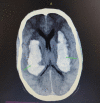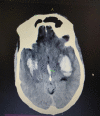Nontraumatic spontaneous bilateral intracerebral haemorrhage in a young patient: a rare case report
- PMID: 37228924
- PMCID: PMC10205346
- DOI: 10.1097/MS9.0000000000000103
Nontraumatic spontaneous bilateral intracerebral haemorrhage in a young patient: a rare case report
Abstract
Spontaneous bilateral intracerebral haemorrhage is a rare surgical occurrence, especially in young populations with poor prognosis. Hypertension is the leading cause but vascular malformations, infections and rare genetic conditions are also responsible.
Case presentation: Twenty-three-year-old male with no prior comorbidities presented to emergency with sudden onset loss of consciousness and 1 episode of seizure. No history of intoxication or trauma was given. Glasgow Coma Scale at presentation was E1V2M2. CT scan head revealed bilateral basal ganglia haematoma along intraventricular haemorrhage.
Clinical discussion: The patient was managed conservatively in the Neurosurgical Intensive care unit. Supportive management was provided. The patient's motor response was improving and a repeat CT scan showed a resolving haematoma. However, due to poor economic conditions, the patient party left against medical advice.
Conclusion: Spontaneous bilateral basal ganglia haemorrhage is a rare surgical emergency with no clear consensus on a management approach. This case highlights the importance of undiagnosed hypertension in causing intracerebral haemorrhage in poor economic groups.
Keywords: bilateral basal ganglia haemorrhage; case report; conservative management.
Copyright © 2023 the Author(s). Published by Wolters Kluwer Health, Inc.
Conflict of interest statement
The authors declared no relevant financial conflict or any other conflict of interest.
Figures
Similar articles
-
Spontaneous bilateral basal ganglia hemorrhage: an unusual clinical scenario.Oxf Med Case Reports. 2025 Feb 22;2025(2):omae183. doi: 10.1093/omcr/omae183. eCollection 2025 Feb. Oxf Med Case Reports. 2025. PMID: 39990020 Free PMC article.
-
Factors influencing the outcome of spontaneous intracerebral haematoma in a Neurosurgical Hospital in South-East Nigeria.Niger Postgrad Med J. 2019 Apr-Jun;26(2):113-117. doi: 10.4103/npmj.npmj_22_19. Niger Postgrad Med J. 2019. PMID: 31187751
-
Spontaneous Simultaneous Bilateral Basal Ganglia, Thalamic, and Central Pontine Haemorrhage: A Case Report.Cureus. 2024 Feb 5;16(2):e53674. doi: 10.7759/cureus.53674. eCollection 2024 Feb. Cureus. 2024. PMID: 38455820 Free PMC article.
-
Fatal thrombolysis-related intracerebral haemorrhage associated with amyloid-β-related angiitis in a middle-aged patient - case report and literature review.BMC Neurol. 2022 Dec 23;22(1):500. doi: 10.1186/s12883-022-03029-x. BMC Neurol. 2022. PMID: 36564732 Free PMC article. Review.
-
[Bilateral acute subdural haematoma without subarachnoid haemorrhage secondary to rupture of an anterior communicating aneurysm. A case report and review of the literature].Rev Neurol. 2018 Sep 16;67(6):210-214. Rev Neurol. 2018. PMID: 30183061 Review. Spanish.
References
-
- Alhashim A, Hadhiah K, Al-Dandan H, et al. . Spontaneous Simultaneous Bilateral Basal Ganglia Hemorrhage (SSBBGH): Systematic Review and Data Analysis on Epidemiology, Clinical Feature, Location of Bleeding, Etiology, Therapeutic Intervention and Outcome. Vasc Health Risk Manag 2022;18:267–276. - PMC - PubMed
-
- van Asch CJ, Luitse MJ, Rinkel GJ, et al. . Incidence, case fatality, and functional outcome of intracerebral haemorrhage over time, according to age, sex, and ethnic origin: a systematic review and meta-analysis. Lancet Neurol 2010;9:167–176. - PubMed
-
- Takeuchi S, Takasato Y, Masaoka H, et al. . Simultaneous multiple hypertensive intracranial hemorrhages. J Clin Neurosci 2011;18:1215–1218. - PubMed
-
- McGee SM, McGee DN, McGee MB. Spontaneous intracerebral hemorrhage related to methamphetamine abuse: autopsy findings and clinical correlation. Am J Forensic Med Pathol 2004;25:334–337. - PubMed
-
- Ertl-Wagner B, Jansen O, Schwab S, et al. . Bilateral basal ganglion haemorrhage in diabetic ketoacidotic coma: case report. Neuroradiology 1999;41:670–673. - PubMed
LinkOut - more resources
Full Text Sources




